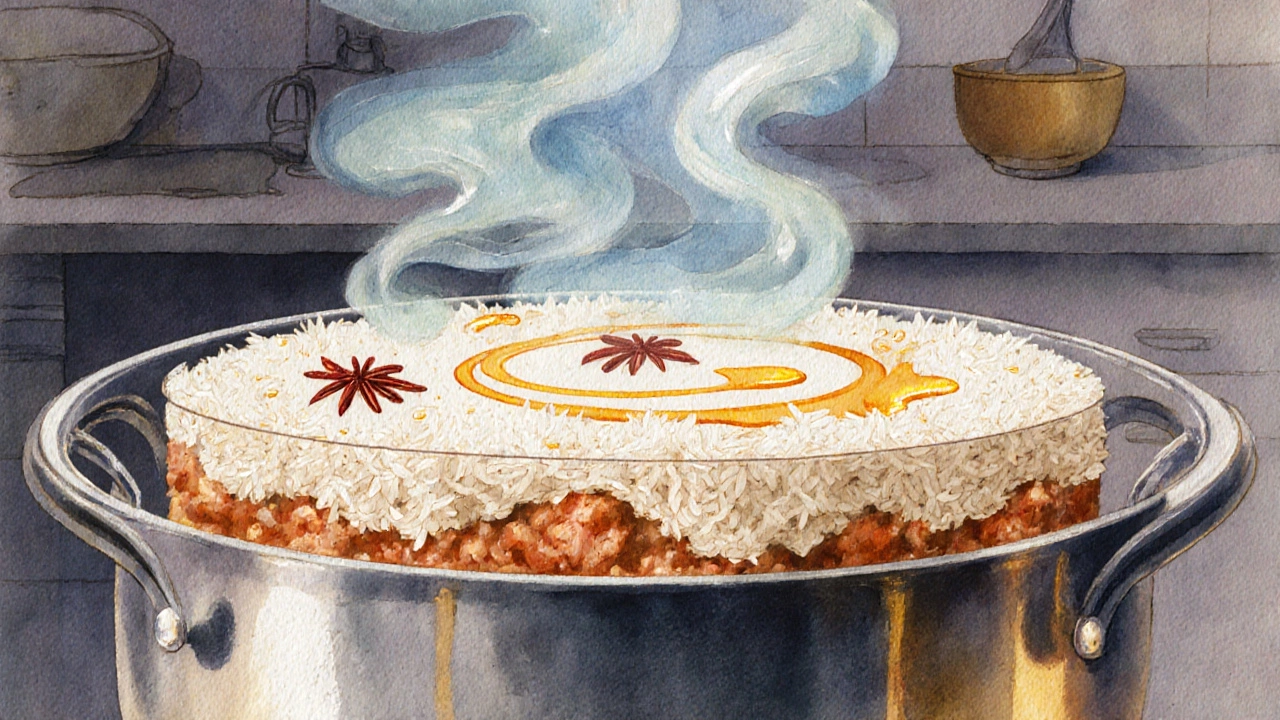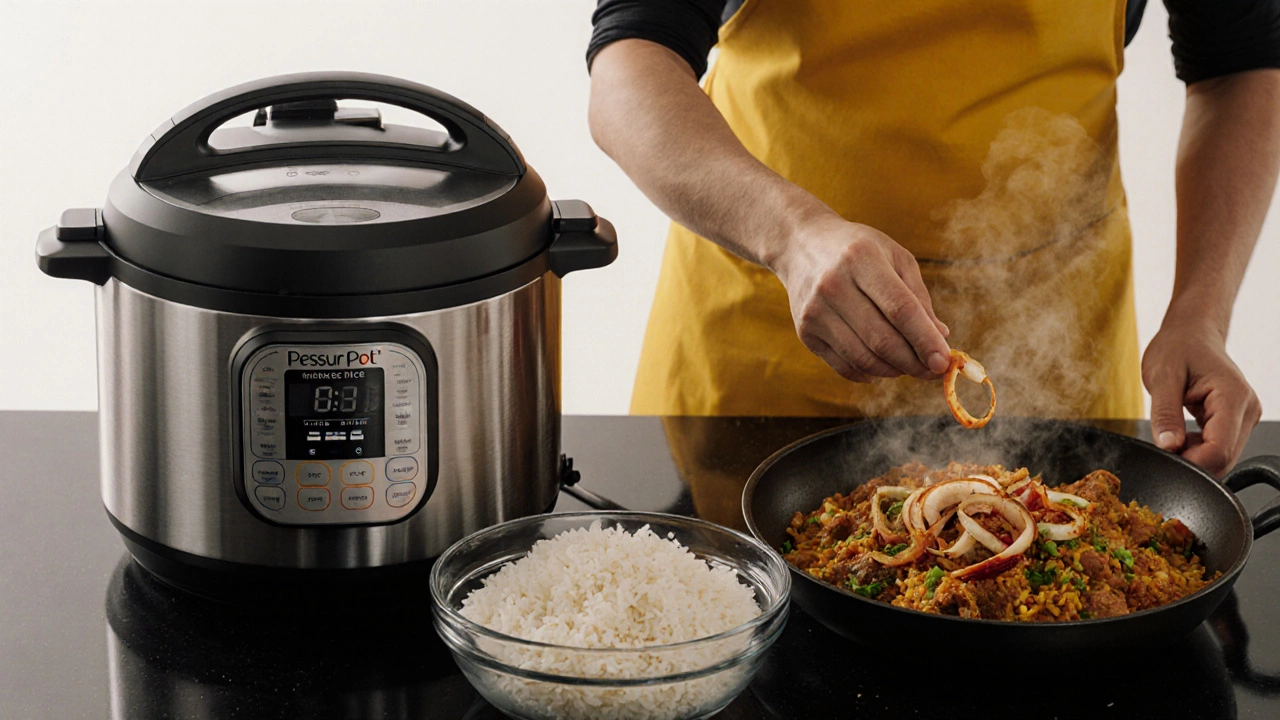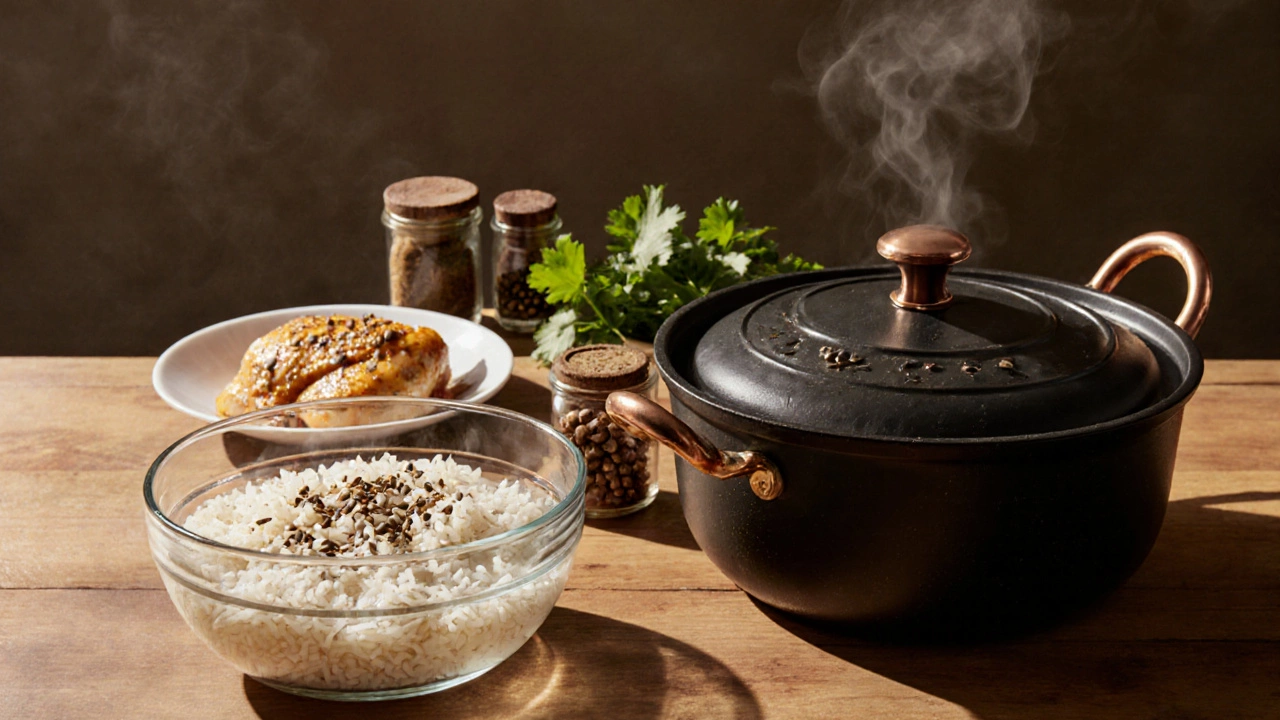Biryani Cooking Time Calculator
How to Use
Enter your cooking method and techniques to estimate total time
Estimated Total Time
Ever opened the kitchen after a marathon biryani session and wondered why it feels like you just baked a cake? You’re not alone. The rich, layered aroma comes at a price-time. Below we break down every step that drags the clock, the science behind it, and practical shortcuts that keep the flavor intact.
What Makes Biryani a Time‑Intensive Dish?
At its core, biryani is a marriage of three time‑hungry elements: Basmati rice is a long‑grain variety that needs precise hydration, Chicken (or any protein) requires slow tenderisation, and the Dum cooking method seals in steam for hours. Each component has a purpose, but each also adds minutes-or hours-if not handled correctly.
The Science of Rice Absorption and Steam
Unlike quick‑cook rice, Basmati rice has a thick husk that resists water. The grains need to absorb just enough moisture to stay fluffy, not mushy. If you rush the soak or use the wrong water‑to‑rice ratio, the rice will either stay hard (requiring extra simmer time) or turn soggy, prompting a second round of steaming.
Steam is the real hero in biryani. During the Dum cooking phase, the pot is sealed, allowing moisture to circulate slowly. This gentle, uniform heat lets flavors migrate from meat and spices into the rice. The trade‑off? A low‑heat environment means the clock keeps ticking.
Why the Meat (or Veg) Takes Time
Marinating meat in yogurt, ginger‑garlic paste, and spices does more than add flavor; it begins breaking down muscle fibers. However, that process is slow. When you finally sear the meat, the outer layer cooks fast, but the interior still needs the low‑heat dum environment to become tender. Skipping this step often results in a chewy bite, forcing you to extend the cooking time later to fix it.
Even vegetarian proteins like paneer or tofu benefit from the slow steam. Their texture can become rubbery if exposed to high heat too quickly, so a gentle dum soak is still recommended.

Layering & Flavor Diffusion - The Real Time Suck
Traditional biryani isn’t just rice and meat tossed together. You layer par‑cooked rice over a spiced gravy, add a drizzle of Ghee, sprinkle Saffron‑infused milk, and sometimes toss in fried onions. Each layer creates a barrier that the steam must slowly penetrate.
Think of it like a multi‑layered cake: the heat has to travel through each tier. That’s why a biryani that’s rushed often turns out uneven-some rice grains stay dry while others become over‑cooked.
Common Time‑Wasters and How to Avoid Them
- Overcrowding the pot. Packing too much rice and meat forces the steam to struggle, extending the dum period.
- Low heat. Turning the flame down too much can double the cooking time. A steady medium‑low heat is ideal.
- Incorrect water ratio. Too much water means you’ll need to evaporate it later, adding extra minutes.
- Skipping the rice pre‑soak. Unsoaked rice takes longer to soften during dum.
Practical Tips to Cut Down Cooking Time Without Sacrificing Taste
- Pre‑soak the rice. Soak Basmati rice for at least 30 minutes. This reduces the dum steam needed for full hydration.
- Par‑boil the rice. Bring the soaked rice to 70 % doneness before layering. It finishes in the dum stage without a long wait.
- Pressure‑cook the meat. Use a Pressure cooker or Instant Pot for 10‑12 minutes before adding to the biryani. The meat will be tender, and the dum phase can be shortened.
- Use a heavy‑bottomed pot with a tight seal. A good Dutch oven or a thick‑walled casserole traps steam efficiently, letting you keep the heat slightly higher without burning.
- Pre‑heat the oven. If you finish your biryani in the oven, a pre‑heated 180 °C (350 °F) oven reduces the sealing time compared to a stovetop pot.
- Deploy a heat diffuser. It spreads the flame evenly, preventing hotspots that force you to lower the temperature and lengthen the cook.
- Layer with care. Alternate rice and gravy in thin layers rather than thick blocks so steam penetrates faster.
Follow these steps and you can shave 15‑20 minutes off a typical 1‑hour biryani without losing that signature aroma.

Comparison of Popular Cooking Methods
| Method | Typical Total Time | Flavor Depth | Equipment Needed | Ease of Use |
|---|---|---|---|---|
| Stovetop Dum cooking | 45‑60 min | Very high - slow steam infuses every grain | Heavy pot with tight lid | Medium - requires attention to heat |
| Oven | 35‑45 min | High - even heat, good seal | Oven‑safe casserole | Easy - set and forget |
| Pressure Cooker | 25‑35 min | Moderate - steam is intense but short | Pressure cooker/Instant Pot | Easy - timer based |
| Instant Pot (Manual Mode) | 30‑40 min | High - programmable steam cycles | Instant Pot | Very easy - push button |
Quick Checklist - Make Sure You’re Not Missing Anything
- Soak Basmati rice 30 min.
- Par‑boil rice to 70 %.
- Pressure‑cook meat or use a fast‑marinade.
- Use a heavy‑bottomed, tight‑lid pot.
- Layer thinly, alternating rice and gravy.
- Seal with dough or foil, then cook on medium‑low.
- Rest for 10 min after heat off - flavors finish migrating.
Frequently Asked Questions
Why does biryani take longer than regular rice dishes?
Biryani layers partially cooked rice with a spiced meat gravy, then seals the pot for a slow dum steam. The steam has to travel through each layer, tenderise the meat and let the aromatic spices infuse, which naturally adds time.
Can I speed up biryani without losing flavor?
Yes. Soak the rice, par‑boil it, pressure‑cook the protein, and use a well‑sealed heavy pot. These steps cut the dum stage by 15‑20 minutes while keeping the depth of flavor.
Is using a pressure cooker ‘cheating’?
Not at all. Modern biryani chefs use pressure cookers to tenderise meat quickly, then finish with a brief dum steam for aroma. The result is authentic taste with less waiting.
What temperature should the dum stage be?
Keep the pot on low‑medium heat (around 150 °F / 65 °C internal temperature). Too high and the rice will scorch; too low and the steam won’t circulate efficiently.
Do I need to rest the biryani after cooking?
A 10‑minute rest off the heat lets the steam settle and the flavors meld. Skipping this step can make the top layer dry.
Understanding why biryani takes time helps you respect the process and, more importantly, gives you levers to speed it up. Next time you plan a family feast, you’ll know exactly where to focus your effort and still serve a fragrant, fluffy bowl of joy.
